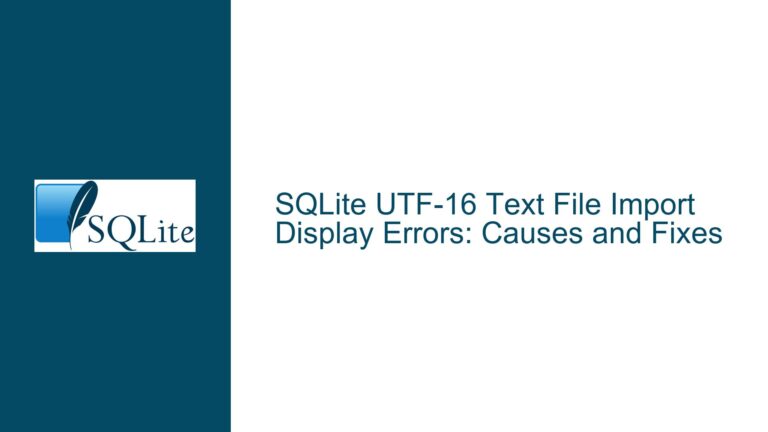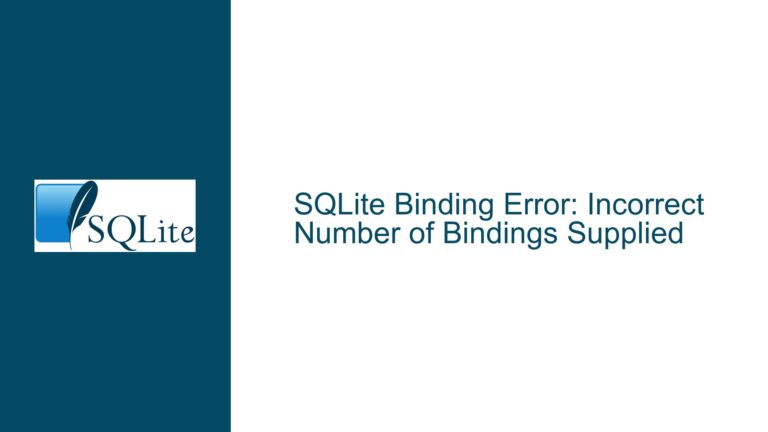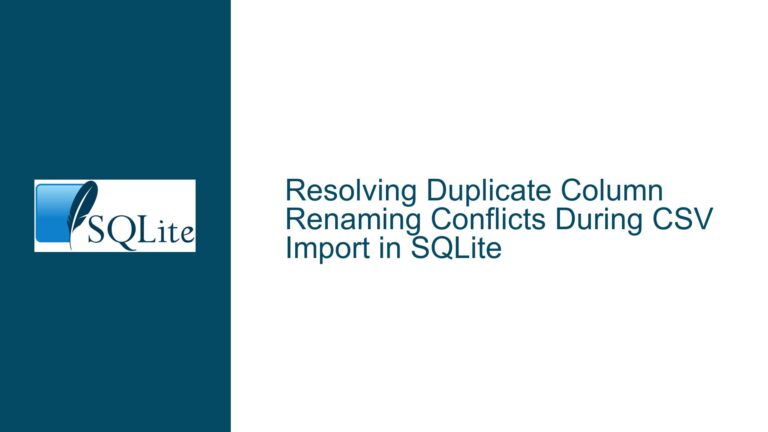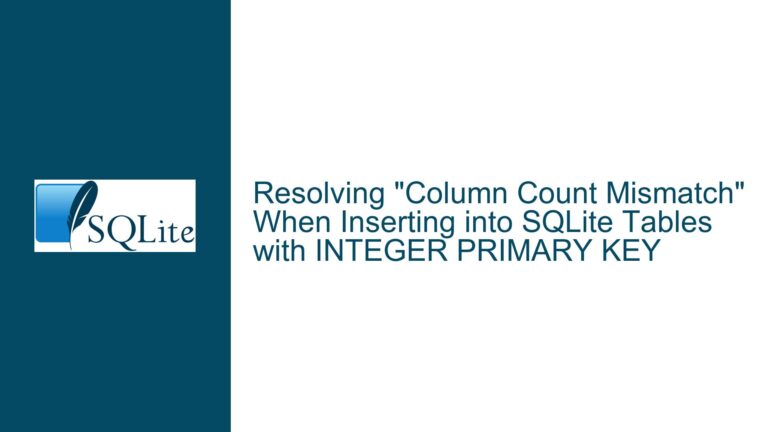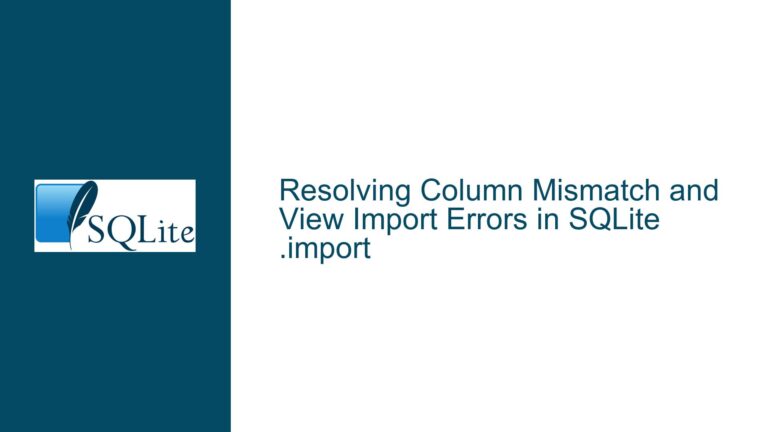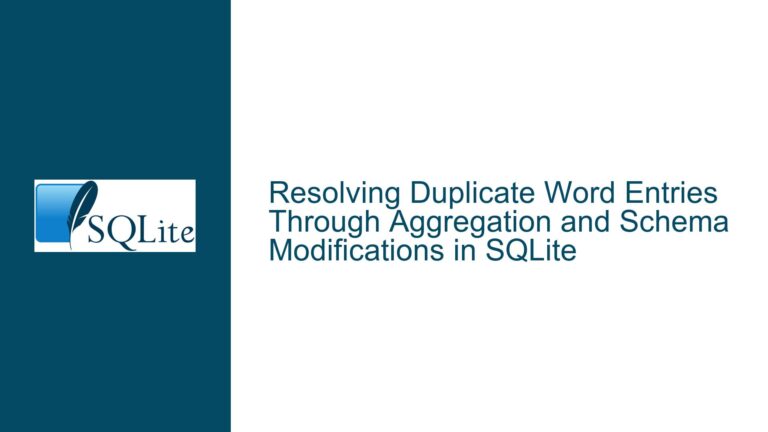Programmatically Importing CSV Data into SQLite via Lazarus: Solutions and Workarounds
Understanding the Challenge of CSV-to-SQLite Import Automation in Lazarus Applications
The core challenge involves automating the import of CSV data into an SQLite database within a Lazarus application while avoiding reliance on third-party tools like DB Browser or the SQLite command-line interface (CLI). Developers familiar with SQLite’s CLI .import command often attempt to replicate this functionality directly in code, only to discover that the Lazarus SQLite connector does not support CLI-style dot commands. This discrepancy arises because SQLite’s C library – which Lazarus interfaces with – does not natively include CSV parsing or CLI-like import utilities. The confusion between CLI tooling and library capabilities is a common pitfall, compounded by the need to handle CSV formatting nuances (e.g., delimiters, escaping) and schema management (table creation, data type matching).
A critical constraint is the requirement to perform all operations programmatically without user intervention, as end-users may lack technical expertise. The Lazarus environment adds complexity due to its Pascal-based ecosystem, which has fewer modern CSV parsing libraries compared to Python or JavaScript. Solutions must balance performance (especially for datasets with 1,000–2,000 records), ease of implementation, and compatibility with SQLite’s transactional model to ensure data integrity during bulk inserts.
Why Direct CLI-Style CSV Import Fails in Programmatic SQLite Workflows
The inability to use .import or .separator commands in Lazarus stems from architectural differences between the SQLite CLI and its embedded library. The CLI is a standalone application that interprets dot commands as part of its shell environment, translating them into lower-level SQLite API calls and file operations. When Lazarus interacts with SQLite via components like TSQLConnector or TSQLQuery, it bypasses the CLI entirely, communicating directly with the SQLite library. This library lacks built-in CSV parsing capabilities, leaving developers responsible for implementing data transformation layers.
Another factor is schema inference. The CLI’s .import command automatically creates tables based on CSV headers, guessing column types as TEXT. In programmatic workflows, developers must explicitly define table schemas before importing data, requiring additional code to map CSV columns to database fields. Mismatched data types (e.g., importing numeric strings into INTEGER columns) can lead to silent failures or constraint violations if not handled proactively.
Resource limitations in embedded environments exacerbate these issues. Loading large CSV files into memory for parsing may not be feasible in resource-constrained Lazarus applications, necessitating streaming approaches or batch processing. Additionally, SQLite’s transaction management must be carefully orchestrated to avoid excessive disk I/O during bulk inserts, which can degrade performance when handling thousands of records.
Implementing Robust CSV Import Functionality in Lazarus with SQLite
Method 1: Manual CSV Parsing and Batch Insertion Using Lazarus Datasets
Step 1: CSV File Reading and Parsing
Leverage Pascal’s TStringList or TFileStream to read the CSV file line by line. For structured parsing, split each line using the SplitString function with the comma delimiter (or a custom delimiter if specified). Handle quoted fields and escaped characters by implementing a state machine that tracks whether the parser is inside a quoted block. For example:
var
CSVLines: TStringList;
CurrentLine: String;
Fields: TStringArray;
i: Integer;
begin
CSVLines := TStringList.Create;
try
CSVLines.LoadFromFile('my.csv');
for i := 1 to CSVLines.Count - 1 do // Skip header row
begin
CurrentLine := CSVLines[i];
Fields := ParseCSVLine(CurrentLine); // Custom parsing function
// Proceed to database insertion
end;
finally
CSVLines.Free;
end;
end;
Step 2: Dynamic Table Creation
Before importing data, ensure the target table exists with a schema matching the CSV structure. Extract column names from the CSV header row and define appropriate data types. Use CREATE TABLE IF NOT EXISTS with explicit column types to avoid defaulting to TEXT:
SQLConnector1.ExecuteDirect(
'CREATE TABLE IF NOT EXISTS qsotabelle (' +
'qso_id INTEGER PRIMARY KEY AUTOINCREMENT, ' +
'call_sign TEXT NOT NULL, ' +
'frequency REAL, ' +
'qso_date DATE);'
);
Step 3: Parameterized Batch Insertion
To optimize performance and prevent SQL injection, use parameterized queries within a transaction. Batch inserts in groups of 100–500 rows to balance memory usage and transaction overhead:
SQLQuery1.SQL.Text := 'INSERT INTO qsotabelle (call_sign, frequency, qso_date) VALUES (:call, :freq, :date)';
SQLConnector1.StartTransaction;
try
for i := 0 to High(CSVData) do
begin
SQLQuery1.Params.ParamByName('call').AsString := CSVData[i].CallSign;
SQLQuery1.Params.ParamByName('freq').AsFloat := CSVData[i].Frequency;
SQLQuery1.Params.ParamByName('date').AsDate := CSVData[i].QsoDate;
SQLQuery1.ExecSQL;
if i mod 100 = 0 then
begin
SQLConnector1.CommitRetaining; // Flush every 100 rows
end;
end;
SQLConnector1.Commit;
except
SQLConnector1.Rollback;
raise;
end;
Method 2: Leveraging SQLite’s CSV Virtual Table Extension
Step 1: Compiling the CSV Extension
Download the SQLite CSV Virtual Table extension source (csv.c) from the SQLite repository. Compile it into a shared library (e.g., sqlite3_csv.dll on Windows) using a C compiler. Lazarus applications can load this extension at runtime using sqlite3_load_extension, but ensure the SQLite library is compiled with extension loading enabled (avoid using SQLITE_OMIT_LOAD_EXTENSION).
Step 2: Loading the Extension and Creating a Virtual Table
In Lazarus, load the extension and define a virtual table mapped to the CSV file:
// Enable extension loading
SQLConnector1.ExecuteDirect('SELECT load_extension(''sqlite3_csv.dll'')');
// Create virtual table linked to CSV
SQLConnector1.ExecuteDirect(
'CREATE VIRTUAL TABLE temp.csv_data USING csv(filename=''my.csv'', header=YES)'
);
Step 3: Migrating Data to Persistent Table
Use an INSERT INTO ... SELECT statement to copy data from the virtual table to the target table, applying any necessary type conversions:
SQLConnector1.ExecuteDirect(
'INSERT INTO qsotabelle (call_sign, frequency, qso_date) ' +
'SELECT call, CAST(freq AS REAL), date FROM temp.csv_data'
);
Step 4: Cleanup
Drop the virtual table after migration to avoid schema clashes in future imports:
SQLConnector1.ExecuteDirect('DROP TABLE IF EXISTS temp.csv_data');
Method 3: Third-Party Pascal CSV Libraries
Option A: Using CsvDocument
Integrate the CsvDocument library (a popular Pascal CSV parser) to handle complex CSV formats. After parsing, follow the batch insertion pattern from Method 1:
var
CSV: TCSVDocument;
begin
CSV := TCSVDocument.Create;
try
CSV.Delimiter := ',';
CSV.LoadFromFile('my.csv');
for i := 1 to CSV.RowCount - 1 do
begin
CallSign := CSV.Cells[0, i];
Frequency := StrToFloat(CSV.Cells[1, i]);
// ... map other fields
// Execute parameterized insert
end;
finally
CSV.Free;
end;
end;
Option B: Commercial Libraries
Consider commercial solutions like DevArt CSV Reader for Pascal, which offer higher performance for large datasets and support asynchronous loading.
Performance Optimization Techniques
- Disable Indexes During Import: Drop non-critical indexes before bulk inserts and recreate them afterward to speed up write operations.
- Journal Mode Adjustment: Set
PRAGMA journal_mode = MEMORYduring imports to reduce disk I/O, but ensure transactions are atomic to prevent data loss on crashes. - Cache Size Tuning: Increase
PRAGMA cache_size = -2000(2000 KiB) to leverage more memory for page caching.
Error Handling and Data Validation
Implement robust validation checks before insertion:
- Use
TRY_CONVERTorCASTin SQL to handle type mismatches. - Reject rows with missing required fields using Pascal-level checks.
- Log malformed rows to a separate error file for later analysis.
for i := 0 to High(CSVData) do
begin
if CSVData[i].CallSign = '' then
begin
LogError('Missing call sign in row ' + IntToStr(i));
Continue;
end;
// Proceed with insertion
end;
Conclusion
Automating CSV imports in Lazarus with SQLite requires bypassing CLI-dependent approaches and embracing programmatic data handling. Developers must choose between manual parsing (flexible but labor-intensive), virtual tables (elegant but requires extension management), or third-party libraries (balanced but may introduce dependencies). By combining transactional batch inserts, schema validation, and performance optimizations, robust CSV import functionality can be achieved without external tools, ensuring scalability even for datasets exceeding 2,000 records.

